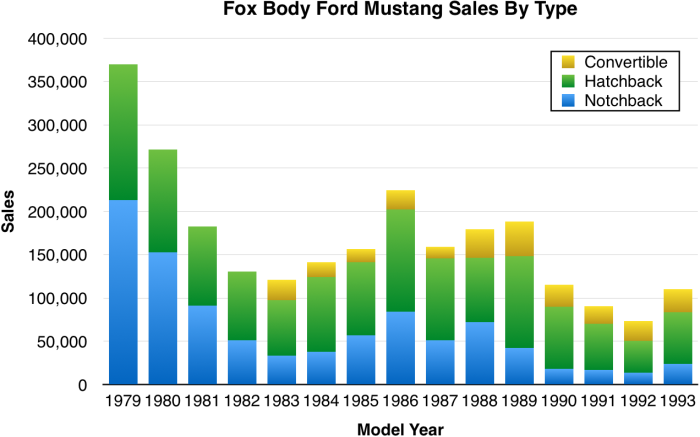“A sports car for the 80’s.”
1980 was the second year for the Fox-body Mustang and brought few changes from the debut year—and some of those weren’t great, such as a downgraded V8. The Cobra inherited some features from 1979 Pace Car, including a front spoiler, dual fog lamps, and a rear deck spoiler.
The standard powertrain on the base Mustang was Ford’s Lima 88 bhp 2.3 liter/140 ci inline four with a Motorcraft 5200 two-barrel carburetor matched with a four-speed manual. A Windsor 119 bhp 4.2 liter/255 ci V8 with a Motorcraft 2150 two-barrel carburetor was available with a three-speed automatic, but the top-of-the-line powertrain was a turbocharged version of the Lima inline four with a Holley 6500 two-barrel carburetor making 132 bhp paired with the four-speed manual. Thus, for 1980 the fastest available Mustang had a 0-60 time of a little under 11 seconds. With a 12.5-gallon fuel tank and 18 city/30 highway fuel mileage (about 15/25 by today’s standards), a Cobra‘s proud new owner could expect a range of about 225 to 270 miles with a 10% fuel reserve.
Standard mechanical equipment on the $7,098 Cobra (about $23,700 in today’s dollars) included the turbocharged inline four, the four-speed manual, a “special suspension system” with heavy duty front and rear stabilizer bars and special shock valving, a sport-tuned exhaust with bright tailpipe extension, and Michelin TRX 190/65R390 tires (they’re still available!) on 15.3-inch forged aluminum wheels. Exterior equipment included dual remote styled mirrors and black lower bodyside paint. A Cobra‘s interior didn’t have many upgrades, but you did get an 8,000-rpm tachometer and a black engine-turned instrument panel applique.
Standard equipment on all Mustang hatchback coupes included dual rectangular halogen headlamps, wraparound taillamps, a modified MacPherson strut front suspension, front disc/rear drum brakes, and rack and pinion steering. Inside, full instrumentation (tachometer, trip odometer, fuel/temperature/oil/alternator gauges), a sports steering wheel, color-keyed cut pile carpeting, all vinyl high-back bucket seats, a lockable glove box, and a cigarette lighter were included.
Exterior and mechanical options included Cobra hood graphics ($88), a flip-up open air roof ($219), black liftgate louvers ($141), and a rear window/wiper washer ($79). Inside, you could choose SelectAir conditioning ($538), Recaro high-back bucket seats ($531), an electric rear window defroster ($96), interval windshield wipers ($39), tilt steering wheel ($78), and the power lock group ($113). A series of stereos were available, with the most capable being an AM/FM stereo radio with a cassette tape player ($271). Higher end stereos could be paired with the Premium Sound System ($94), which added a higher-power amplifier and more capable rear speakers.

1980 Ford Mustangs sold decently, accounting for about 23% of Ford’s overall sales in a down year. Reviews of the day were unhappy, but understanding about the loss of the 4.9 liter/302 ci V8 in the middle of the second oil crisis—Car and Driver stated that “Whether you like life with turbochargers or not, you might as well get used to it.”
Folks are definitely collecting these early Fox-body Mustangs. Cobras come up for sale every once in a while in the Hemming’s Motor News classifieds or on eBay Motors, though there aren’t any available right now.
According to Hagerty’s valuation tools, all the money for a 1980 Cobra in #1/Concours condition is an astounding $23,100, with a more normal #3/Good car going for $9,800. Make mine Black, I think, perhaps with those extra-cost Cobra hood graphics.
Later Fox-body Mustangs I have covered include the 1982 GT hatchback coupe, the 1983 GT convertible, and the 1984 SVO hatchback coupe. I guess I’ll have to get to the second half of the Mustang’s decade at some point.




